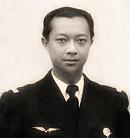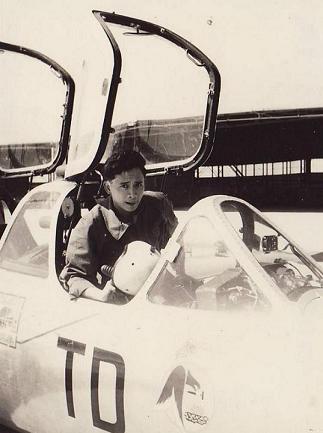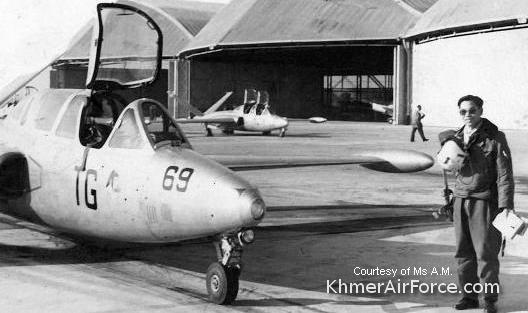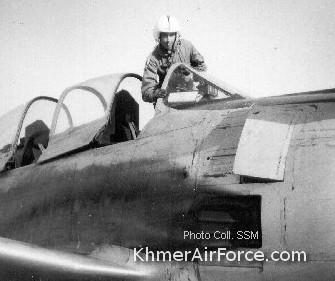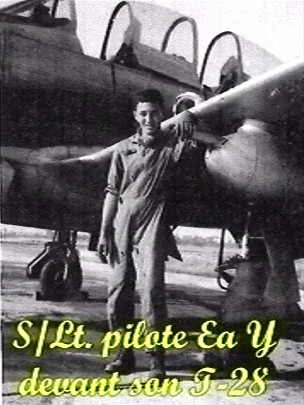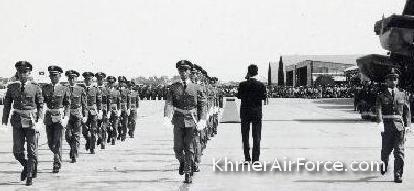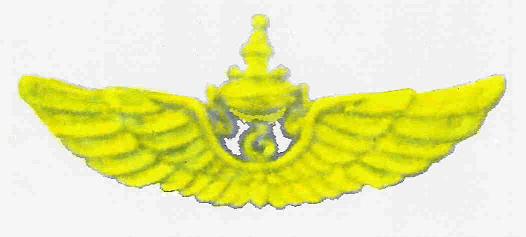 |
| Home | AVRK | AVNK | KAF | Links |
L'Aviation
Royale Khmère
The Beginning
|
Before
and during World War II, very few fellow-countrymen had the pleasure
of flying airplanes. As Cambodia was part
of the French Union, the
few Khmer pilots of that time flew within the French Air Force. In
1939, Prince Sisowath Monipong went to the French Air Academy
at Salon de Provence, and during World War II, Prince Sisowath Sundeth
served as a B-26 Marauder’s pilot with the Free French Air Force
and fought during the Campaign of Italy.
Sisowath Monipong, 1939 >>
see "Les Debuts" |
Later on, several Army officers got their private pilot certificate at the Phnom-Penh Flying Club. Some of them joined the Aviation Royale Khmère (AVRK), when it was created in 1954.
In 1940, during the conflict over Cambodian western provinces between France and Thailand, ally of Japan, it seems there were no Cambodian pilots among the French aviators. We pay tribute to all the French aviators who fought in the Cambodian sky but may our French friends forgive us, this is part of another Story....
In
1945 after the departure of the Japanese forces, the only remaining
Air Force in Cambodia was the French Armée de l’Air. It continued to
provide air transport and some close air support missions during the
Indochina War. In 1953 the French finally made plans for an autonomous
military Khmer Aviation.
In
April 1954, a royal decree officially created the
'Aviation Royale Khmère' (AVRK). Ngo Hou, a doctor and flying
club pilot, was appointed as the Chief of Staff of the AVRK. Keu Pau
Ann, a former inspector of the Department of Forestry, as
well as a member of the flying club, became his assistant. Both
respectively received the
assimilated ranks of Lieutenant-Colonel and Captain. A staff was
formed with army officers, assisted by French Air Force advisers
placed under the command of Major De Salabery.
| Immediately, a
group of French Air Force advisers set an instruction program for the
future Khmer aviators (see. notes of pilot instructor André Bellouard)
The first recruiting campaign was launched. Several
contingents of technical students were subsequently sent to different
specialty
schools in France. Five air cadets then entered the Class 1954 of the
prestigious French Air Academy (Ecole de l’Air) at salon de Provence to
be trained as pilot officers. Two more air cadets later joined the same
academy as technical-engineer officer. (See 'Ecole Militaire de l’Air' Air Academy 1954).
Meantime at Pochentong, the new Royal Flying School, under the command
of French Captain Robert Carbonel, began the training of eighteen
Khmer pilot students of Class 1 (1954). Fletcher 25D  |
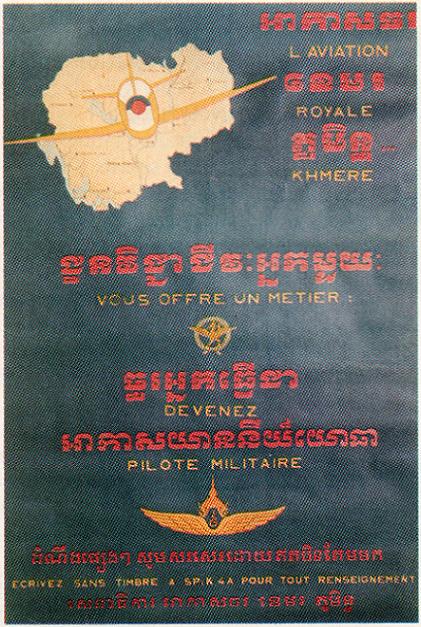 Ph Cdt Gacoin via A.Grandolini |
1954 Class One of the 'Ecole Royale Khmère de Pilotage'
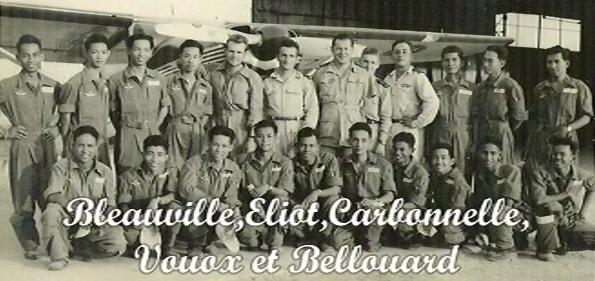
The
instructors at the Royal Flying School were exclusively French. At the end of their training,
four of Class One students were selected to attend a complete three years French
training cycle at the French Air Academy, Salon de Provence (Class
55).
For
these students and all the others, over several years, the advanced
trainings and the application schools marked out their beginning
career. They had attended various French schools at Marrakesh (French
Morocco), Tours, Cazaux , and Nancy for fighter pilots and Avord and
Toulouse for transport pilots. Some of them also attended the CESA
(Centre d’Enseignement Supérieur de l’Armée de l’Air), the Command and
Staff College, at Paris. Some others moreover went to Germany for
advanced trainings in close air support techniques according to NATO
standards.
... Class 1, 1954 ..continue...
At
the beginning of 1955 the Royal flying school began to receive the first brand new Morane Saulnier 733 training aircrafts.
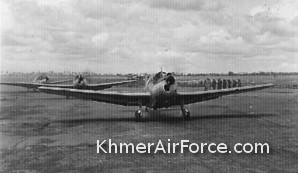
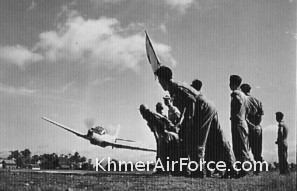
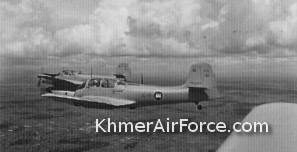
Meanwhile, in 1954, the French had opened a school for the
non-commissioned mechanical officers. After graduation, these students
completed their training cycle in France where others had also directly
started their instruction, particularly at Rochefort.
1955 Class Two
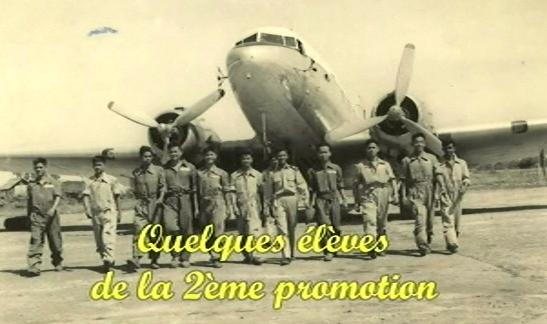
Between 1955 and 1956, there were several incursions of Vietnamese communists in Cambodia but the young and still organizing AVRK played no role in pushing them back. Its first pilots were in fact still in advanced training stages in France and the newly organized Intervention Group was not yet fully operational.
1956
There was no recruitment for the Royal flying school in 1956, but three Cambodian air cadets entered the French Air Academy and Air Military School at Salon de Provence for administration, telecommunication and technical courses (see Salon 1956). The Americans started to deliver eight Cessna L-19A Bird Dogs and three DHC L-20 Beavers. In France the advanced trainings continued with good results.
Satto (left) and Bounky, "Promotion 55, Ecole de l'Air de Salon de Provence" (French air academy) with the new Fougas
>> video available << |
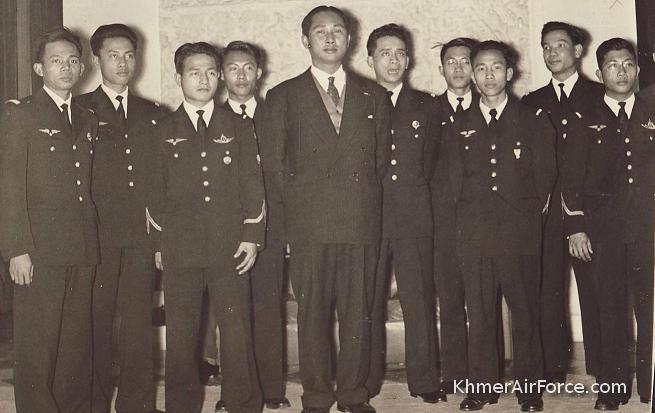 Some of the numerous NCOs trained in France. Here at Paris with four 'Ecole de l'Air française' cadets and Lon Nol, secretary of defense visiting cambodian students in France. |
1957 - 1958
In 1957 there was again
no recruitment. After following a special preparation-course, the air
cadets sent to Salon in 1955 successfully graduated, but they would be
the last ones for there was no more air cadet pilot sent afterwards to
the French Air Academy. Only advanced training continued to
take place in France in the subsequent years. For some unknown reason,
overall, there was little recruitment during the fifteen years of the
AVRK era.
Along with the training program undertaken, the
Pochentong Air Force Base was improved with the expansion of the
parking area, the construction of more hangars and buildings for
different services as well as new facilities for the various setting up
flying units.
Avord, 1957-58. Cne Pau Ann, Lts Butha, Doeun and Saphat. In front of an MD-315, Mao Kim Sourn.
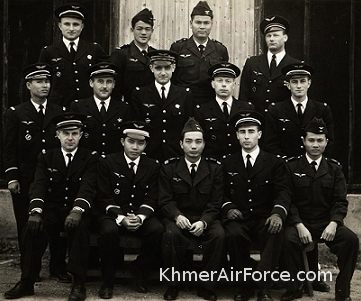
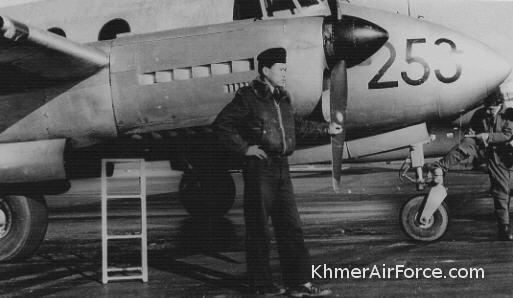
From 1957 to 1958, seven C-47s and fourteen T-6G Texans
were delivered to the AVRK by the United States Military Assistance
Advisory Group (USMAAG). Two C-47s were bought from Israel.
Additional
to the Flying School, different groups are now setting up: the
Territorial Group which runs up administrative tasks, the Technical
Group for maintenance of equipments and aircraft and the Air Tactical
Group (GATAC, Groupement Aérien Tactique) with its three squadron-sized
units:
- the Observation and Accompanied in Combat
Group
- the Intervention Group
- the Liaison and Transport Group
The
Transport Group, as it had done since the beginning, carried out
regular flights for the benefit of the new provinces of Koh Kong,
Rattanakiri, and Mondulkiri.
Inventory 1958 (source A.Grandolini)
| Royal Flying School 15 Morane Saulnier MS 733 Alcyon Intervention Group 3 Fletcher FD-25B 14 T6-G Texan Observation and Combat Accompanying Group 8 Cessna L-19 Bird Dog |
Transport and Liaison Group 2 Cessna 170 2 Cessna 180 3 DHC L-20 Beaver 9 Douglas C 47 2 Douglas DC 3 |

1958 Class Three
In
Indochina, the general trend of France policy was toward the withdrawal
from the area, letting the Americans stepped in and get more and more
involved in neighboring Vietnam. On the contrary, in Cambodia, the
French military continued to play an important part in the development
of the AVRK.
Since
the creation of the AVRK, the Royal Flying School was practically
directed by French advisers, commanded successively by Captain Carbonel
and then Captain Gaspard. At the end of 1958, command was gradually transferred
for the first time to a Cambodian officer, Lieutenant
Norodom Vatvani. The school was renamed Royal Air Academy. With the
help of the French and Cambodian flight instructors, Vatvani was in
charge of the pilot training until 1970. From 1954 to 1970,
the Royal Air Academy had trained only seven classes with a total
of one hundred sixty navigators and pilots.
 |
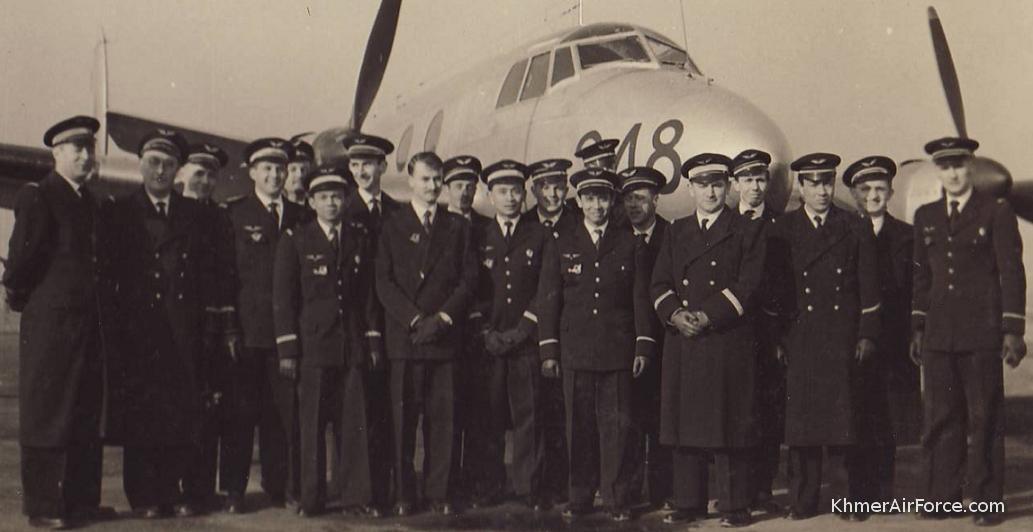 |
| Privates, pilots, French advisers and instructors. Ven Runnath (méca. nav.), ?, ?, ?, Kuch Cheng Heng (méca. nav.), Keam Edouard (Off Méca.), Cdt Gacouin, ?, ?, Pao Lim Sina. |
Avord airbase, 1959. Baley, Satto et Sithiya |
1960 Class Four
Before being considered as "Aspirant" (Officer Cadet), two years of studies are now mandatory.
The
Transport Group accomplished innumerable flights to the foreign
countries for the numerous official visits of the Chief of State. At
the beginning, the crew members for the Chief of State’s airplane were
exclusively French. The others airplanes were flown by Khmer crews. In
1960, the Transport group took its first trips for a long overseas
journey to Cairo, Belgrade, Zagreb, and Skopje.
|
In
1962, the
AVRK went to visit the neighbouring countries in the south of Cambodia
including
stops at Jakarta, Singapore and Kuala Lumpur. Then to the west, the AVRK
flew as far as Calcutta, Delhi, Poona, Bengalore and Madras;
the return flights were via Mandalay in Burma. From Mandalay they headed
for Kunming and Nanning in the communist China. These two last stages
were true adventures. In bad weather conditions over the high
mountains, the radio
communications with the air traffic control stations were really bad.
At that time, in
that region of China, the only navigation aids were the “gonio”
Goniometric system (see the travel logs) |
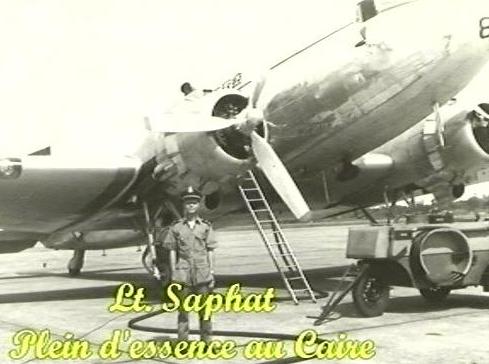 |
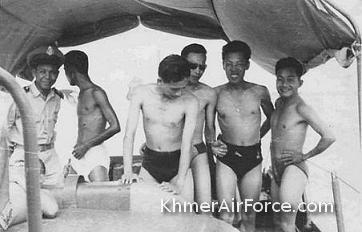
|
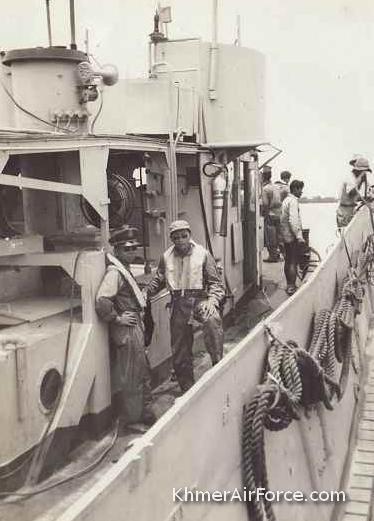 |
1961 The
Fouga Magisters
(see video in the Links page)
Since
1956 in France, our pilots were already trained on jet aircrafts like Fouga
Magister CM-170s at the French Air Academy (1957), and later on, our fighter
pilots flew on T-33s and Mystère IVs at Tours, Cazaux, and
Nancy. But it was not until 1961 that the AVRK got its own Fouga Magister
CM-170 jet aircrafts.
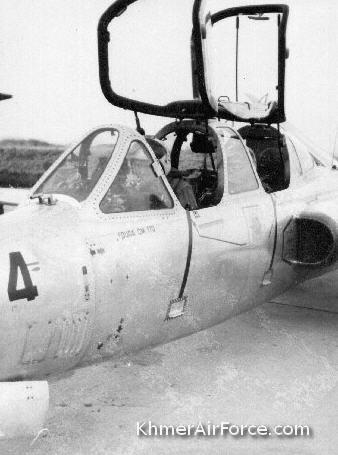 Cne Sam Or |
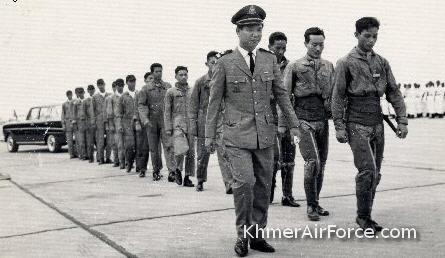 Sor Bunky and a pilot detachment for a demonstration flight |
 (see videos in the Links page) |
A small group of pilots went to the US Air Force Bases (Williams AFB ?, Lackland AFB) to fly on American Jets fighters. Several other, after their training in France, were sent to Russia for conversion-training on Mig-15s and Mig-17s. It was not enjoyable experiences.
1962 Class Five
|
In
1962, the AVRK started to take part in combat operations. The
AVRK T-6Gs carried out air supports to the Khmer ground troops in the
region of Takeo. They drove a group of armed Vietnamese belonging to
a religious sect of Dao Hòa Hào away from Cambodian
soil. This group progressively came to settle in Cambodia
and then expelled the Cambodian peasants from their lands.
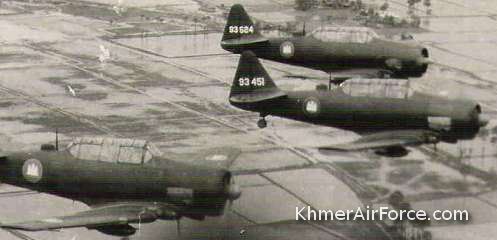 |
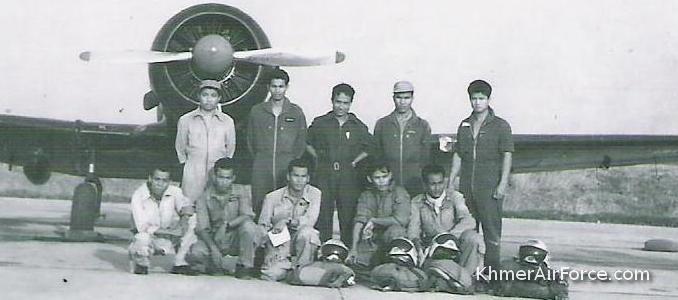 Penn Randa, Sok Sambaur, Pal Sam Or, Thach Penn, Sisowath Monirak Ma Kim Oeurn, Neang Lee, Som Kuon, Som Bora, Om Kon |
1963 American T-37s and Russian MIG-15s and MIG-17s
After
French Fouga Magister CM-170 jet airplanes, the USA delivered the
T-37s. A few months later, the Russians brought in the MiG-15UTIs, and
Mig-17Fs. One year later, the Chinese came with additional MiG-17s. The
AVRK was now equipped with a hundred aircrafts of different types. This
variety of aircrafts was nothing else than tremendous logistic problems
for maintenance and supply. Moreover, the Chief of State, Sihanouk,
ordered the United States Military Assistance Advisory Group (USMAAG)
to leave Cambodia in January 1964. The American technical support was
then subsequently suspended. Fortunately, AVRK had an excellent
technical department with highly qualified technical officers and
non-commissioned officers, as well as a staff of French advisers, who
were able to fill in some of the deficiencies. In 1964, the technical
services then started to perform general overhauls for the MS-733s,
Cessna 170s, 180s, L-19s, and carried out partial overhauls of the
C-47s and MD-315s. The C-47s for their complete overhauls were sent to
the Hong Kong Aircraft Engineering Company (HAECO). For the T-28s and
the helicopters, the AVRK mechanics dismantled the engines and we
conveyed them in our C-47 cargos to the HAECO as well for a complete
check and repairing. Overall, the AVRK managed to keep a high training
level for its pilots.
1963 Class Six
| Six month of military training during the initial three year studies : |
 Phok Kim Onn |
Diplomatic relations and the Chief of State trips to foreign countries increased at a good pace during those years. Steadily, the AVRK staff officers also started to take part in military and diplomatic delegations.
